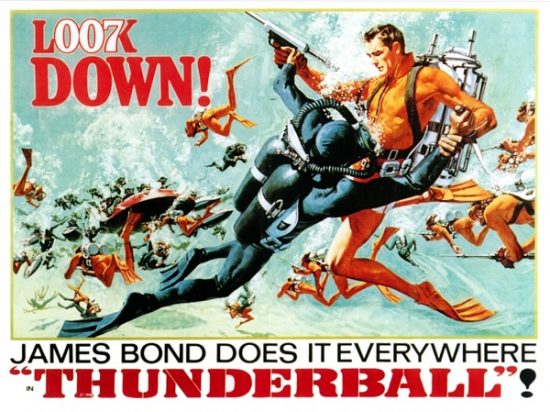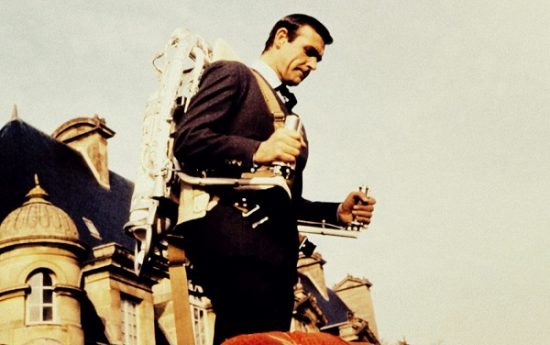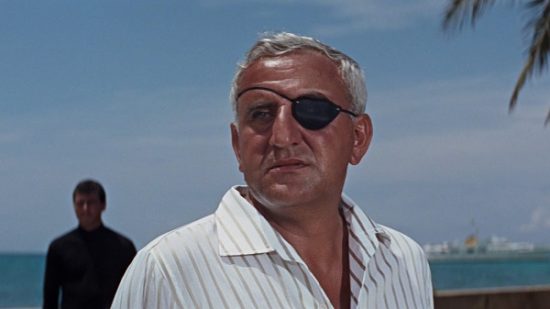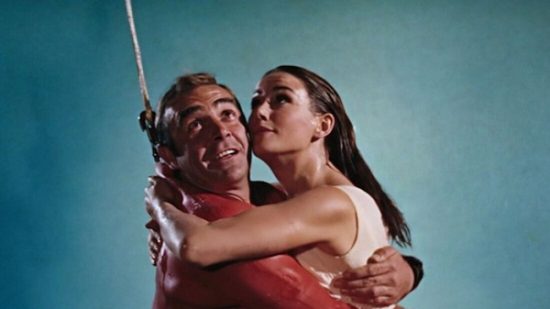Bond Blog: Thunderball – A James Bond Retrospective
Originally planned as the first James Bond movie, a long-lasting legal dispute pushed Thunderball back to become the fourth entry in the now established genre. Keyed up by the accumulative iconic power of the genre and the high quality of Goldfinger, the film became a break-out box office hit.
Thunderball was originally written as a screenplay by Ian Fleming, Kevin McCloy, and Jack Whittington. Fleming later wrote the novel based on the screenplay without the permission of his collaborators and the project became a thorn in the side of EON productions and would later lead to a rival Bond movie Never Say Never Again and a delay in the Timothy Dalton Bonds which saw the Welsh actor star in only two movies. The story is fairly strong with SPECTRE agent Largo (Adolfo Celli) conspiring to steal two nuclear missiles and hold the world to ransom with the threat of destroying a city. This plot would be recycled in You Only Live Twice and The Spy Who Loved Me, which led to further lawsuits.
But the film also marks some other negative developments in the franchise. The gadgetry becomes totally ridiculous with the rocket pack feeling like a moment of opportunism on the part of the producers. It makes little or no sense as part of the plot and with the terrible bad projection – a continuing feature of the film – isn’t even particularly visually impressive. Other problems include a bloated running time, an uninspiring villain, and a weary-looking Connery, whose humour begins to smack of a glib disregard for the action.
The film starts with another fake death – something of a recurring feature of the Bond movies. This time it’s a French Major and SPECTRE agent. His transvestism allows for a good joke with Bond punching the widow in the face before a furniture fight worthy of The Prisoner of Zenda. Following this pre-credit sequence, we find Bond in a health farm recovering from his last assignment and fortuitously coming into contact with his next when another patient at the same clinic is embroiled in a plot to hijack a Vulcan bomber via a surgically constructed doppelganger and poison gas. There is an element of unnecessary complexity to the plot but in the end, a lead takes Bond to Nassau. There he meets up with yet another Felix Leiter – so far we’ve had three actors in the role: this time the deliciously named Rik Van Nutter – and Largo, along with Domino, the sister of the murdered pilot and played by Claudine Auger though again dubbed by Nikki van Der Syl who had also dubbed Ursula Andress. The Bond girls may look different but their voices are usually coming from the same mouth. A renowned Italian theater actor, Celi also was dubbed by Robert Rietti, who would go on to dub Tiger in You Only Live Twice. The Bond producers seemed unconcerned about having an actor who could give a complete performance. They wanted someone who could look a certain way – male or female – and then the rest they’d fix in post. Similarly, van Nutter got his part because he was a dining companion – along with his wife Anita Ekberg – with Cubby Broccoli. Bond productions were becoming a kind of club with a crew who would return again and again, an ensemble of actors, including voice actors, and writers and directors along with friends and acquaintances who could pop in and do a role.
Similarly, the special effects had – as already mentioned – a smack of opportunism. A fast-speed boat would be noticed and that would go in the film. The underwater rocket rig Bond uses was a US Navy contraption and quite dangerous according to Ken Adam, but it looked fun so in it goes. Likewise, the final hook system which seems like a lunatic way of ending the film when you imagine the risks of breaking your neck or dying in any number of ways. But it provides an excitingly silly conclusion though it does mean Bond has to forego his usual post-mission coitus, unless of course he does it mid-air, which now I think of it is probably what we’re supposed to assume.
The sharks are real as well and caused Connery another hair raising moment when one of them swam under the partition that was supposed to be separating him from the dangerous predators. The film is a mix of in-camera special effects and stunts, often impressive, frequently at the expense of credibility, and piss poor back projection.
Thunderball is one of the Bonds I can remember watching as a kid that I would never finish. I would drift off and do something else. This is partly because it gets lost in the section of the Junkanoo carnival which the film goes back and forth to, along with Bond. This section will reappear in Moonraker in the Rio section, but here it feels like the local colour is being milked for all it is worth. It isn’t bad in itself, it’s just the meandering storyline that loses all sense of urgency. When one of Bond’s helpers Paula (Martine Beswick who had already appeared in From Russia with Love as a fighting gypsy girl) is killed, it is noted perfunctorily. This is supposed to underline Bond’s callousness but it also makes for a fairly flat drama. Nothing really matters even if Miami might get hit by a nuclear bomb, though we know it’s never going to happen. In fact, the cavalry arrives in the form of a scuba diving SWAT team a good fifteen minutes from the end. At that point, the film is essentially over but we have to put up with a seemingly endless underwater battle scene. We’ve already had a lot of underwater stuff and although I’m sure it’s dangerous and technically challenging to film, it doesn’t look particularly exciting. A poor shark turns up midway through and gets speared in an all-too-realistic manner.
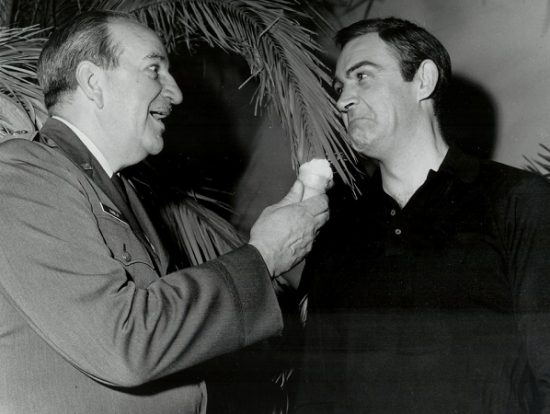
Yet it’s a handsome and sporadically exciting adventure. With Terrence Young returning, the humour works quite well. Connery has some throwaway lines which he delivers with suitable contempt. But one suspects this is partly inspired by his increasing disenchantment with the whole palaver. ‘I find that fame tends to turn one from an actor and a human being into a piece of merchandise,’ he told Playboy magazine, the only interview he did for the film. His performance has become a little flatter as has his toupee which sits atop his head like a hair hat and adds an extra spice to watching as you try to spot the line. The Tom Jones theme song blares with suitably pigheaded sexiness and John Barry’s score is a soothing consolation during so much Man from Atlantis action. The huge success of the film – with the critics also getting behind it – meant that the producers would go on, but as with any success, there was always the danger they would learn the wrong lessons. More gimmicks would be added, more gadgets, more girls, more locations. There would be longer films as well – Thunderball is the 9th longest Bond movie – culminating in Spectre’s unforgivable 148 minutes. But the story would be repeated so much so that the authors of Thunderball would claim that they had essentially created the template for Bond movies from then on.

